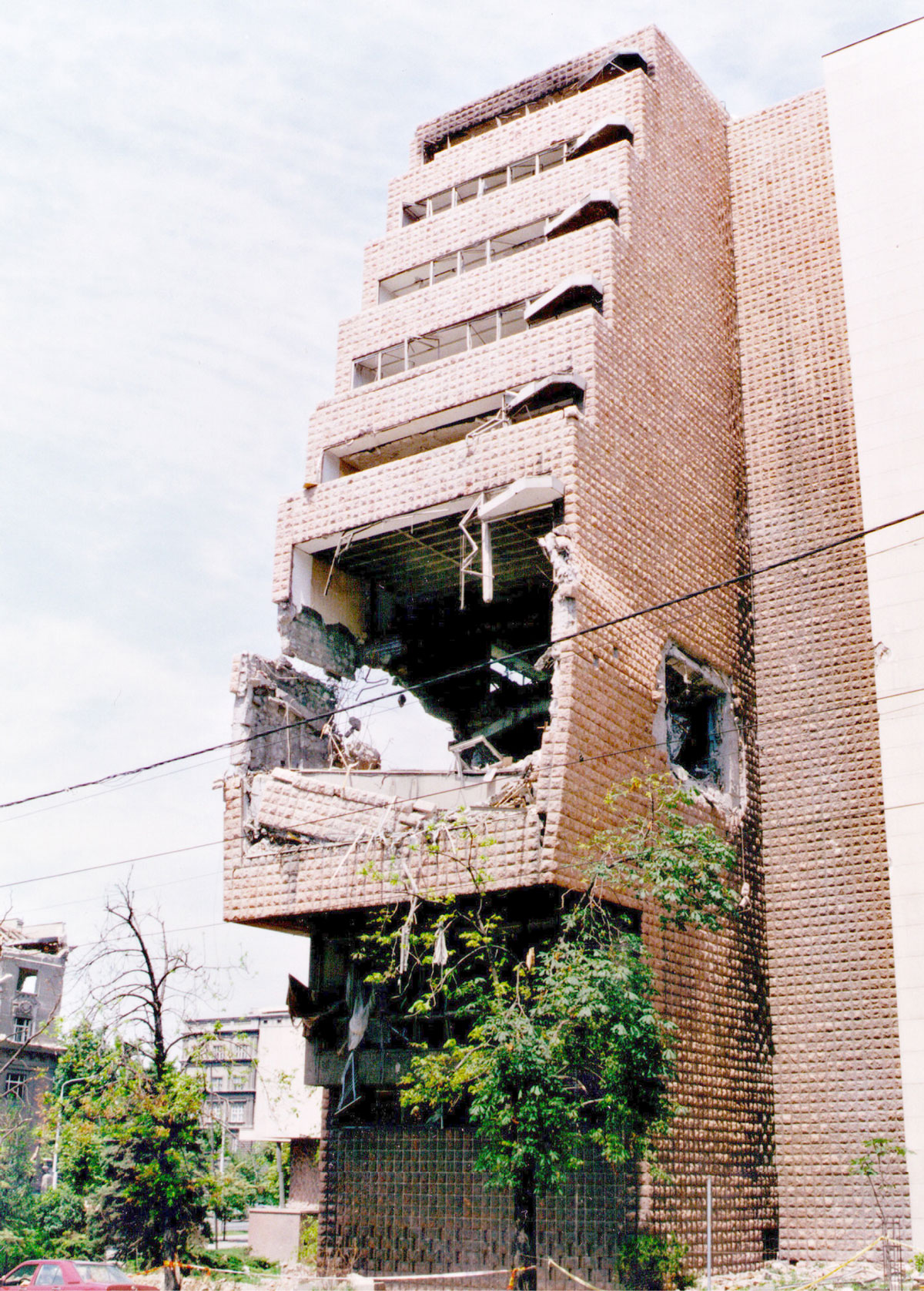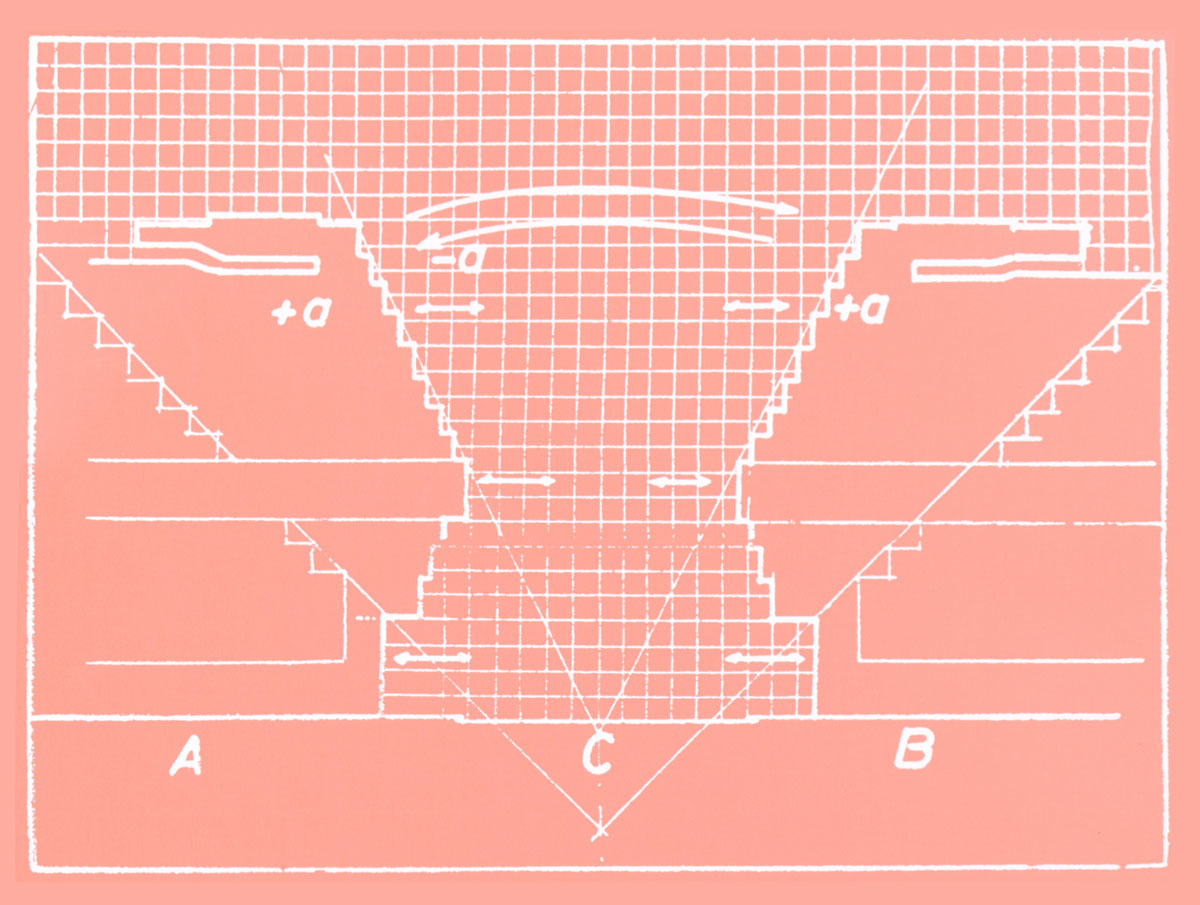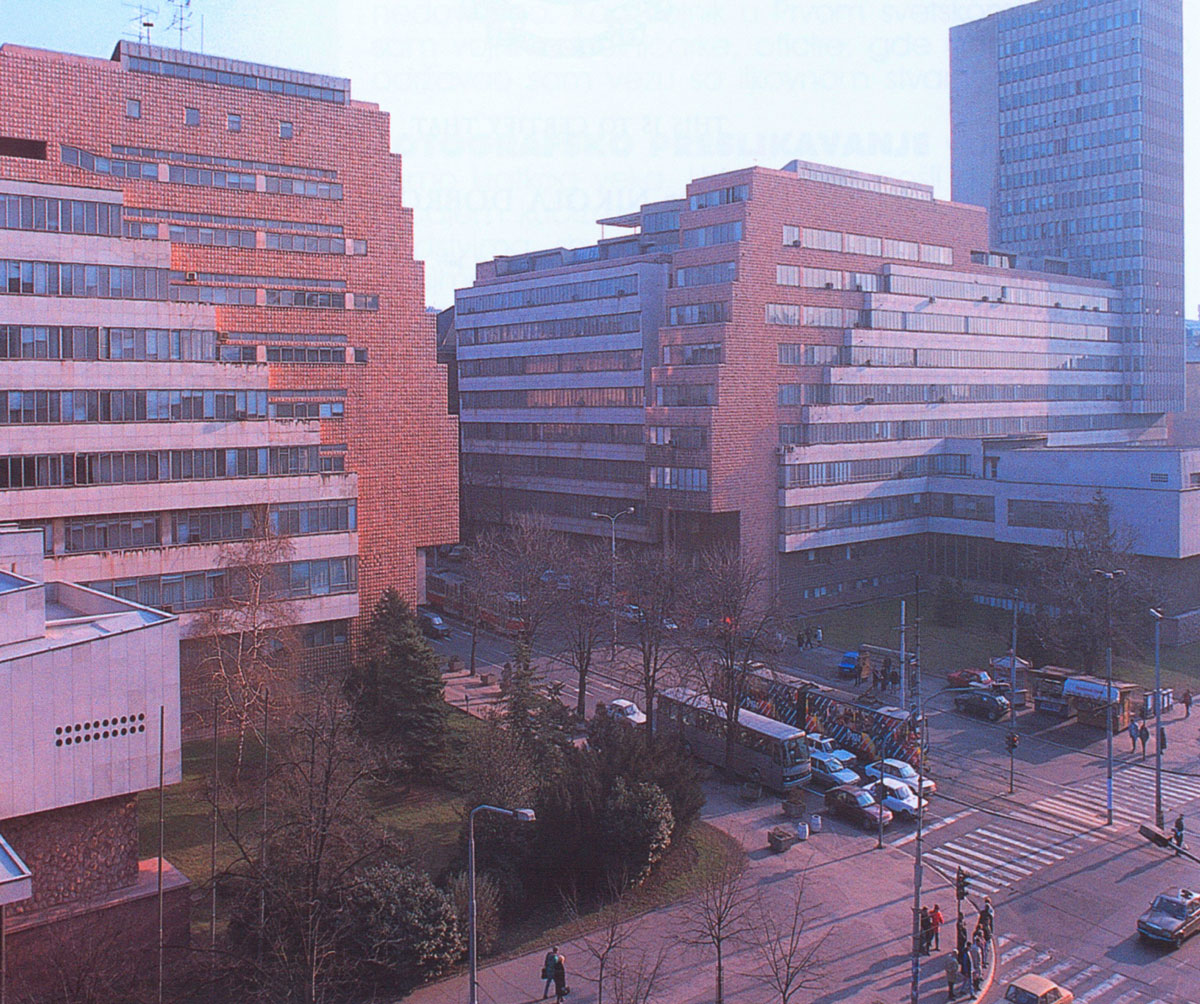NATO as Architectural Critic
Destruction and classification
Srdjan Jovanovic Weiss

In war, the time of destruction is also the time of classification. In its role as a bomber targeting a selection of urban artifacts, NATO faced a problem of identification: how to read architecture that neither looked Stalinist nor had the classical aspirations of the Third Reich. The empty administration buildings in downtown Belgrade in the vicinity of hospitals and schools, the empty Federal Ministry of Internal Affairs and the empty Army Headquarters built by a recipient of the Gold Medal of the Royal Institute of British Architects, all bombed by NATO, were important examples of Serbian post-war modernism.[1] The result was that during the air campaign NATO unwittingly demonstrated excellent taste in placing architectural landmarks from this century on its target list.[2] As part “of a new struggle against fascism,” NATO selected to destroy the very buildings constructed in the post-war period to symbolize the struggle of a “stubborn nation against fascism.”[3] While modernism that came from the West was bombed, some conservative examples were “preserved.” Beli Dvor for example, or the White Palace, an eclectic Palladian-type villa built in the 30s, where Milosevic, like Tito before him, normally greets guests but does not live, was considered off-limits as a target because of a Rembrandt canvas kept on its first floor.[4] In history books, Fascist architecture such as the Third Reich’s is always understood in relation to its conditions of creation. The architecture used by the current state in Serbia was built before the world found the Serbian state to be nationalist, but in bombing Serbia, NATO also branded examples of Serbian post-war modernism as Fascist. Once caught in the fire of the global media, this architecture, built under a pro-Western liberal influence, is now in danger of being branded as Fascist, of being remembered in relation to its conditions of destruction.
There is, however, a complication in laying sole responsibility for the bombing of these particular buildings on NATO. On the streets of Belgrade particular buildings were anticipated to be likely targets. “Most people believe that the urban centers will be ‘cruised,’ and official propaganda does as much as possible to support this belief. Indeed, civilian casualties would be a tremendous boost for the Serbian government’s propaganda war against the rest of the world.”[5] This is a sentiment that could be read in an analysis published on the Internet in October 1998, half a year before NATO bombing began. The government’s position was possible in part because it has not expressed any ambition to create its own architectural rhetoric. Fully appropriating the previous communist buildings and infrastructure, in its ten-year rule the government has neither built nor commissioned a single piece of architecture, except for a recent Neo-classicist monument which celebrates the one-year anniversary of the end of NATO bombing. Therefore the current regime had no difficulties sacrificing these buildings to NATO.
The building of the Army Headquarters coincided with the construction of the post-war national identity in Yugoslavia shortly after the break from Stalin in 1948. During the spring of 1954 the Yugoslav Army invited nine Yugoslav architects to compete for a new building complex. Already quite old, Josip Plecnik, an established academic from Ljubljana, was also asked to elaborate a solution outside of the competition and advise on the questions of urban analysis and composition. The others were asked to participate anonymously. One of them was Nikola Dobrovic, already known in leftist circles of the European intellectual avant-garde for his modernist work. Even before the competition, Theo van Doesburg, the Dutch modernist, had singled out the work of these two architects in explaining the “construction” of Yugoslav national identity. His view was that both architects had developed their styles thanks to conflicting influences mainly arriving from Western Europe. Both were pioneers in resisting the influence of tradition.[6] These two architects had nevertheless developed entirely different, if not opposite, vocabularies of formal expression. Van Doesburg described Plecnik’s approach to “constructing” identity as the practice of an “honest” Neo-classicist. On the other hand, even though he criticized Dobrovic for being “a true academic [not capable] in his work of formulating the constructive system of a building,” the Dutch painter praised him as one of “the first voices to be liberated from the limiting ties of Yugoslav tradition and to reach out toward mutual innovation in the art and architecture of Middle and Western Europe.”[7] Plecnik, the “honest” Neo-classicist, was there in order to legitimize the government’s project of reconfiguring this important part of the city, and Dobrovic, an “academic” with a “liberating voice,” was there to serve as proof of the recent shift in Yugoslav politics towards a pro-liberal image endorsed by the West.


Plecnik submitted three different schemes for the site, which measured 270 by 100 meters and was divided in two by a large street. Plecnik derived his schemes from an earlier design for a Slovenian Parliament in Ljubljana in 1947, a polemical yet well-known Neo-classical proposal. In spite of the jury of generals in Belgrade praising his efforts as the best urban concept, they decided to find the winner among the anonymous entries. The pro-liberal experiment that was Yugoslavia after the break with the Eastern Bloc was unlikely to favor Plecnik’s Neo-classicist variations on national identity, especially since Stalin had already appropriated the Neo-classicist image for the communist state. The undesired proximity of Plecnik’s use of the vertical column and a classical volume to the triumphalistic style of, for example, Ivan Zholtovsky, one of Stalin’s favorite architects, was perhaps too unappealing in the eyes of the pro-liberal Yugoslav jury. Yugoslavia was about to choose a new image for its Army Headquarters and Nikola Dobrovic knew that very well. His idea of symbolizing the Army within such a transitional society was not to be literal, by, for example, “placing tanks on top of Neo-classical buildings,” like his counterpart in Russia Lev Rudnev had proposed for the Army Headquarters in Moscow.[8]
In contrast, Dobrovic won with a scheme stripped of any classical representations of power. Not even a single modernist round column survived his very personal concept of “engaged volumetric shaping” and his painterly methods of achieving “visual dynamics.” The changes and the liberalization of a transitional state such as Yugoslavia were to be shaped into a volume, not expressed as a narrative. The street front across the site had already been filled with pre-war representational buildings in a variety of academic and Neo-classical styles. Dobrovic’s proposal connected the two divided areas of the site by proposing a long and narrow volume from one end of the site to the other with a full length of 250 meters, thus keeping a space open for the street coming up the hill from the main railway station to the city. By setting this volume back from the line of the crossing street, Dobrovic created a 270-meter wide field open for experiments in elevation. The void in that elevation evoked a canyon and Dobrovic imagined the void as an integral part of his new image of national identity.
“Visual, mobile, and transitional” was Dobrovic’s description of the new individual capable of negotiating this new form of architecture. As an academic, he attempted to translate a philosophical speculation into form. For the 270-meter elevation plane, he created a series of diagrams that he called “Bergson’s diagrams,” referring to the French philosopher Henri Bergson. The focus of all the diagrams was “the void,” somewhere in the middle of the elevation plane. In the circles of Belgrade intellectuals these, by now mythic, “Bergson diagrams” defining the visual dynamism and tension in the main elevation of the complex were used to construct the visual identity of a winning nation from World War II. Dobrovic characterized these diagrams as the depicting “the engagement of space, that new visual order, that new, powerful fluid architectonics of the formally created environment.”[9] The diagrams formalized the idea of the “visual dynamics” of a building complex built to be visually experienced by a contemporary citizen always on the move—“Homo spatiosus” was his name for this person conscious of his continuous motion. Dobrovic’s contemporary individual could not stand still. Dobrovic based his idea of “engaged space” through motion on the presence of the void. Changing perspectives, visual depths and visual layering were to be triggered by movement through the void of the proposed building complex. The character of the void keeps it visually inseparable from the two parts of the building. The diagrams depicted four variations on visual engagement: “symmetrical,” “asymmetrical,” and two labeled as “extravagant.” The jury was fond of the symmetrical one.
These diagrams demonstrated the shift in the role of architectonics when the task at hand was to represent a state. For Dobrovic, the architectonics of his “engaged space” was analogous to a musical score being played continuously by the listener.[10] A viewer for Dobrovic is someone who finds an imprint of his or her self in “the voids [that] acquire their visual existence and belonging” through this very act.
There are no records of diagrams of spatial conditions in the works of the French philosopher. Bergson died in 1941. It is possible that Dobrovic, led by intuition and an unrestricted desire to absorb and work from Western ideas, created and named the “Bergson diagrams” himself. A possible justification for him doing so can be found in a book about Bergson written by Gilles Deleuze.[11] This book called Bergsonism was published in 1966, only two years after the completion of Dobrovic’s Army Headquarters building. The thesis of Deleuze’s book is that Bergsonism is an intuitive but rigorous practice of appropriation as a valid kind of discovery. This speculative claim may uncover, but also justify, Dobrovic’s lavish appropriation of Western architecture as actually being his discovery. His intuitive takeover of and the transformation of Bergson’s ideas on space and mobility may place the Army Headquarters building among the rare examples of this appropriative tradition, if not the only such example.
To the press, NATO explained its five-step target selection procedure as follows:
1. Targets are suggested at NATO’s headquarters in Brussels as well as in Germany and Italy.
2. A cell in Pentagon called J-2T studies feasibility of the target.
3. The planners measure the strategic value of a target against the drawbacks.
4. Lawyers at the Pentagon and at NATO’s headquarters work on justifying the targets.
5. Presidents of major NATO countries review the target list.[12]
Since it was already anticipated as a target by Belgrade’s citizens, it would be a surprise if the Army Headquarters did not appear early on the list in Brussels. The feasibility of targeting a large building in the heart of the city was itself not enough for the decision, however. The critical moment arrives with the strategic evaluation of the target and of its importance within the war machine. It is also the moment of testing the extent to which the target can be justified through the creation of public support in the media. NATO had to present the war machine to a public that identified the targets as the “organs” of an anthropomorphic enemy. The combined rhetoric of “heart” and “brain” freed NATO from having to deal with the specificity of the architectural targets. Projecting the effects of destruction, the classification of good or bad nominees on the list of bombing targets liberated NATO from responsibility for creating a system of values that was essentially opposed to culture.
During the bombing, NATO continually presented the procedure behind its choice of targets. In the international press, General Wesley Clark divided the targets into “strategic” and “tactical.” Besides air defense, military forces, supply roads, and command and control objects, strategic targets included “sustaining infrastructure and resources.”[13] This comprised not only urban targets, infrastructure, bridges, electrical plants, oil refineries, but also administrative buildings. But what can be the strategic value of a highly visible large building in the center of the city, especially after being emptied of its personnel and equipment? Physically, its strategic value is zero. The only possible strategic justification for the destruction of this building was its symbolic disappearance from the skyline.
But national symbolism was precisely what could not to be found in the Army Headquarters. NATO’s late decision to bomb the building, more than a month after the air attacks had started, may have been the effect of this low level of symbolism: no exposed columns, no ornamental narration of history, as might have been present in Stalinist architecture. For NATO it may have been easier to classify the Army Headquarters if the symbol of power had been a physical entity attached to the building rather than the void between the two parts of the complex. Evocative of the Sutjeska canyon, the place of one of the greatest battles against the Fascist occupation in World War II, it was in fact the result of an academic architectural operation—the intuitive and speculative transformation of the philosophy of Henri Bergson into “dynamic” diagrams that “shaped” the void, the only recognizable symbol in the complex. The identity of the nation was to be found in the void, in non-matter, and in the action of the individual moving through the void.
The circumstances that made it possible to destroy architecture born in the struggle against Fascism in the name of the global policing of Fascism have yet to be studied. In the meantime architects from Belgrade, including Tanja Damljanovic and Vladimir Kulic, have faced the current situation and are adapting the content of their forthcoming guide to the architecture of Belgrade to include the images of the new ruins. This guide juxtaposes the original building and the ruin, and thereby merges opposite methods of architectural classification, one historically critical and based on the creation of the building, and the other realistic and post-critical based on its destruction.
In the case of the Army Headquarters, both methods, however, are relevant. That is because trying to understand the future condition of Yugoslavia’s national identity now asks that we think of two voids in relation to each other: one created by Nikola Dobrovic within his Army Headquarters and the new one created by NATO’s bombs falling on the building. The answer seems like a delayed dilemma about which void to identify with, which void to remember.
- The massive and monotonous Federal Ministry of Internal Affairs, one of the few built examples of Social Realism in Belgrade, was built by Slovenian architect Ludvik Tomori. The Ministry of National Defense in was built between 1954 and 1963 by architect Nikola Dobrovic.
- Vladimir Kulic, “Balkan War Reports,” 3 April 1999, Ctheory. Available here.
- Quotes by Tanja Damljanovic from Belgrade Architecture, eds. Vladimir Kulic, Mirjana Roter Blagojevic, Aleksandar Ignjatovic, Tanja Damljanovic, Renata Jadresin and Ana Radivojevic, scheduled for publication in winter 2000.
- Steve Erlanger, “The Targets; NATO Strikes Serbian TV; Casualties Seen,” The New York Times, 23 April 1999.
- Aleksandar Boskovic, “Belgrade Burning? Report from Belgrade,” 12 October 1998, Ctheory.
- Theo van Doesburg, “Jugoslavija: Suprostavljeni uticaji: Nikola Dobrovic i Srpska tradicija” (Yugoslavia: Conflicting Influences: Nikola Dobrovic and the Serbian Tradition) in Milos R. Perovic and Spasoje Krunic, eds., Nikola Dobrovic: Eseji, projekti, kritike (Belgrade: Arhitektonski fakultet Univerziteta u Beogradu & Muzej arhitekture, 1998), pp. 214–216.
- Van Doesburg, ibid., p. 215.
- Dobrovic refers to Frunze Military Academy in Moscow by Lev Rudnev, a project from 1932–1937. See Nikola Dobrovic, “Pokrenutost prostora—Bergsonove ‘Dinamicke sheme’: Nova likovna sredina,” in Eseji, projekti, kritike, op. cit.
- Dobrovic, p. 116.
- Dobrovic, p. 131.
- Gilles Deleuze, Bergsonism, trans. Hugh Tomlinson and Barbara Habberjam (New York: Zone Books, 1988).
- Eric Schmitt and Steven Lee Myers, “Crisis in the Balkans: The Bombing. NATO Said to Focus Raids on Serb Elite’s Property,” The New York Times, 19 April 1999.
- Article by General Wesley K. Clark, SACEUR, “Effectiveness and Determination,” published in the international press, 2 June 1999. The article is also available on NATO’s website at www.nato.int/kosovo/articles/a990602a.htm.
Srdjan Jovanovic Weiss is an architect from Belgrade living in New York City. He is a co-founder of Normal Group for Architecture, a critical office for architectural theory and practice. He has taught advanced studios in architecture at the Columbia University together with Homa Farjadi and he is one of the authors of the upcoming book Harvard Guide to Shopping with Rem Koolhaas and a group of thesis students. Jovanovic Weiss is a contributing editor of Cabinet.
Spotted an error? Email us at corrections at cabinetmagazine dot org.
If you’ve enjoyed the free articles that we offer on our site, please consider subscribing to our nonprofit magazine. You get twelve online issues and unlimited access to all our archives.